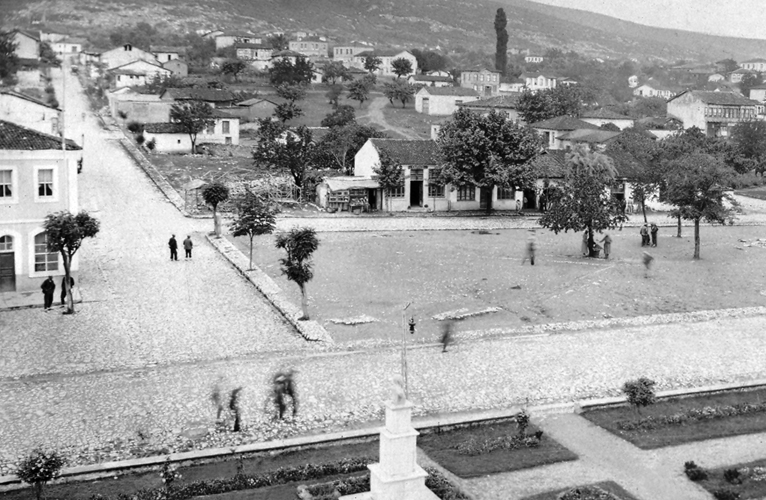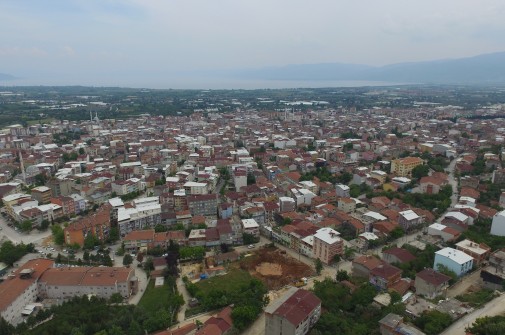Orhangazi is a district of Bursa, located in the south of the Marmara Sea and west of Lake Iznik. Orhangazi, formerly known as Pazarköy, was founded on a fertile plain on the shore of Lake Iznik. While Yalova province is located to its north, Gemlik is to its west, Yenişehir to its south, and Iznik districts to its east. Surrounded by the Samanlı Mountains to the north and the Katırlı Mountains to the south, the district appears in the shape of a basin. The region is 45 kilometers from Bursa city center, approximately 40 minutes away from Bursa.
The district is one of the important junction points on the Bursa-Istanbul Road. Winters in the district are cool, and summers are under the influence of a mild climate. Orhangazi is a dynamic district with a population of over 80,000, distinguished by its strategic location in the northeast of Bursa, between Lake Iznik and the Gulf of Gemlik, its agricultural production branded with Gemlik olives, its rich history extending to Orhan Gazi, the second Ottoman Sultan, and its developing industrial infrastructure.
History
Orhangazi is one of the oldest settlements in Anatolia. As a result of excavations carried out at the Ilıpınar Mound in Orhangazi Topselvi neighborhood, it was understood that the first settlement in the district was established 8000 years ago.
The oldest known inhabitants of Orhangazi are the Bithynian tribe; the region came under Roman rule in 74 BC. The settlement, which transformed into a city under the name of Basilinapolis, was annexed to Byzantium in 395.
The region came under the rule of the Anatolian Seljuk State between 1085-1097. In 1097, the city and its surroundings were plundered by the Crusaders. Between 1024-1261, Iznik came under the domination of the Byzantine Empire.
The region, conquered by Orhan Bey in 1332, was incorporated into Ottoman lands. Orhan Bey had a mosque and a bath built here in his name and settled Turkish tribes from the vicinity. This settlement, which took the name Pazarköy, was at that time connected to Iznik.
In 1879, Pazarköy became a sub-district center. In 1893, it became a district center affiliated with Bursa province and took the name Orhangazi in 1913.
During the War of Independence, the district was occupied by the Greeks and experienced the darkest and most unfortunate period of its history. The occupation between 1920-1922 lasted 2 years. On September 10, 1922, the occupying Greek forces left the district. Since they burned and destroyed everything, the district center was moved to Gürle village for 2 years.
Orhangazi, which existed as a small settlement for a long time after its establishment, showed rapid development first with the increasing importance of the Bursa-Yalova highway, and then with the commissioning of the Istanbul-Izmir highway and the Osmangazi Bridge.

Once Upon a Time Orhangazi (Orhangazi Municipality)
Geography and Climate
- Location & Area: The district center is on the Bursa-Izmir highway (O-5); its total area is 506 km². The district, with Yalova to its north, is neighboring Gemlik, Yenişehir, and Iznik districts.
- Topography: Orhangazi has the Samanlı Mountains to its north, the Katır Mountains to its south, and borders Lake Iznik, Türkiye's fifth largest lake, to its east.
- Climate: Hot, dry summers; cool, rainy winters create a typical Mediterranean/continental transition climate. Annual average temperature varies between 10 - 27 °C; precipitation is 700-900 mm.

Orhangazi Bird's Eye View (Orhangazi Municipality)
Nature and Health
Lake Iznik is one of the primary natural beauties located within the borders of Orhangazi. This area, which is Türkiye's fifth largest lake, stands out with its peaceful atmosphere and green surroundings. Water sports such as sailing, rowing, and canoeing are practiced around the lake; it is especially preferred by nature enthusiasts and campers on weekends. Watching the sunset on the lake shore during summer months offers an indispensable experience for local people and tourists. In addition, amateur fishing events organized in the lake provide an alternative for those who want to spend time intertwined with nature.
Keramet Thermal Springs, located approximately 10 kilometers from the district center, significantly contribute to the region's health tourism with its natural thermal springs. The temperature of the thermal water is approximately 30 °C throughout the year, and it is rumored to be beneficial for many ailments, from skin diseases to rheumatism. In addition to bathing in the calcareous natural pools, the surrounding green areas are suitable for picnics and day trips. Especially in winter, Keramet, attracting visitors with its warm water, experiences an influx of both local and regional tourists.
Trekking and mountain sports are practiced in the Katırlı and Samanlı mountains. Furthermore, Gürle Mountain is very suitable for paragliding, and festivals and competitions are organized there.
Festivals and Cultural Events
In Orhangazi's social life, the Orhangazi Olive Festival, held every year in November, is one of the most important cultural events. Continuously held since 1978, the festival is an important organization reflecting the district's olive growing tradition and agricultural identity. During the festival, the "Olive Beauty" contest, olive oil dish competitions, local product promotions, folk dance shows, and concerts are organized. Additionally, the "Olive Themed Photography Contest" for amateur and professional photographers aims to establish an aesthetic connection between art and nature. The festival is not only an agricultural celebration but also a reflection of Orhangazi's historical and cultural identity.
Local Delicacies
Orhangazi cuisine has a natural and healthy eating culture, with a predominance of olive oil-based dishes due to the intensive production of Gemlik-type olives. Classic Aegean-Mediterranean flavors such as olive oil artichoke, stuffed grape leaves, and stuffed zucchini flowers are frequently found on Orhangazi tables. Additionally, freshwater fish such as carp and catfish caught from Lake Iznik are also served grilled or steamed, adding different tastes to the tables.


